9K52 Luna-M
The 9K52 Luna-M (Russian: Луна; English: moon, NATO reporting name FROG-7) is a Soviet short-range artillery rocket system. It fires unguided and spin-stabilized 9M21 rockets.
| 9K52 Luna-M | |
|---|---|
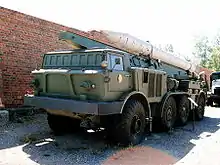 9P113 TEL with 9M21 rocket | |
| Type | Artillery rocket |
| Place of origin | Soviet Union |
| Service history | |
| In service | 1964–present |
| Wars | Soviet–Afghan War, Iran–Iraq War, Lebanese Civil War, Gulf War, Yugoslav Wars, 2003 invasion of Iraq, Libyan Civil War, Syrian Civil War, Yemeni Civil War (2015–present) |
| Production history | |
| Variants | 9M21B (nuclear), 9M21F (HE) and 9M21G (chemical), Laith-90 |
| Specifications (9M21B) | |
| Mass | 2.2–2.5 t (350–390 st) |
| Length | 9 m (30 ft) |
| Diameter | 0.5 m (1 ft 8 in) |
| Crew | 4 |
| Maximum firing range | 70 km (43 mi) |
| Warhead | High explosive, chemical, nuclear |
| Warhead weight | 9M21B:
Nuclear-armed variant, fitted w/ 500 kg warhead 9M21G: fitted w/ 390 kg warhead |
| Maximum speed | Mach 3 |
Launch platform | 8 x 8 ZIL-135 missile launcher |
Description
The 9M21 rockets are mounted on a wheeled 9P113 transporter erector launcher (TEL) based on the ZIL-135 8x8 army truck. The TEL features a large hydraulic crane used for reloading rockets from 9T29 transporters (also ZIL-135 based). The 9M21 has a range up to 70 km and a CEP (circular error probable) between 500 m and 700 m. The road mobile rocket has a 550 kg warhead and is capable of delivering high explosive, nuclear, or chemical warheads.
History
Six of the initial version of the 9M21 were in Cuba during the missile crisis in October 1962. These missiles, which were ready to fire, had nuclear warheads installed. A further 70 warheads were stockpiled on the island.
The Luna was later extensively deployed throughout some Soviet satellite states. The rocket has been widely exported and is now in the possession of a large number of countries.
Syria
In what became its first use in combat, Syrian forces fired a FROG-7 barrage at Galilee on 7 October and 8 October 1973, in the course of the Yom Kippur War. Although aimed at Israeli air bases such as Ramat David, the rockets struck several Israeli settlements. These unintended attacks on civilians gave Israel the justification to launch a sustained air campaign inside Syria itself.[1]
Starting in 2012, during the Syrian Civil War, the Syrian Army fired several FROG-7 rockets against different areas under control of different insurgent formations.[2]
Iraq
Iraq made intensive use of FROG-7 rockets in the war with Iran (1980-88).[3] After the war with Iran, Iraq modified its stock of 9M21s by extending their range to 90 km and fitting a submunition-carrying warhead. The upgraded rocket was renamed Laith-90.[4] On 21 February 1991, during operation Desert Storm, Senegalese troops were hit hard by a Laith-90. Eight Senegalese soldiers were wounded in action as a result.[5]
During the 2003 invasion of Iraq, the Headquarters of the 2nd Brigade, US 3rd Infantry Division, Tactical Operations Center (TOC) of U.S Col. David Perkins, was targeted and struck by either an Iraqi FROG-7[6] rocket or an Ababil-100 SSM missile, killing three soldiers and two embedded journalists. Another 14 soldiers were injured, and 22 vehicles destroyed or seriously damaged, most of them Humvees.[7][8]
Serb forces
In the course of the Yugoslav Wars, Serb forces launched FROG-7 rockets on a number of Croatian towns, like Orašje, in the outskirts of Zupanja,[9] on 2 December 1992, where several civilians were killed,[10] or the capital Zagreb, on 11 September 1993, while the battle of Medak Pocket was still going on.[11]
Libya
RAF jets targeted and destroyed FROG-7 launchers operated by pro-Gaddafi forces south of Sirte in the 2011 Libyan civil war.[12]



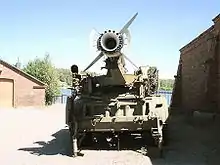
Variants
- 9M21B
- Nuclear-armed variant, fitted with a 500 kg (1,213-lb) warhead.
- 9M21G
- This variant is fitted with a 390 kg (860-lb) warhead.
- Laith-90
- Iraqi version with increased range (90 km) and submunition warhead.
Operators

Current operators
 Algeria -24 – acquired between 1964 and 1974, 15 systems supposed to be decommissioned by 2014.
Algeria -24 – acquired between 1964 and 1974, 15 systems supposed to be decommissioned by 2014.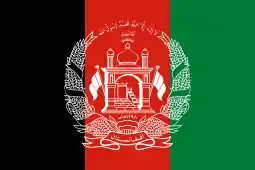 Afghanistan
Afghanistan Belarus - Some (36 units of 9K52 and Tochka)
Belarus - Some (36 units of 9K52 and Tochka) Cuba
Cuba Egypt - 24 launchers acquired between 1960 and 1969, most likely decommissioned
Egypt - 24 launchers acquired between 1960 and 1969, most likely decommissioned Libya - 45
Libya - 45 North Korea - units of 9K52 and 2K6 Luna, called Hwasong-3)[13]
North Korea - units of 9K52 and 2K6 Luna, called Hwasong-3)[13] Russia - Some in storage
Russia - Some in storage Syria - 30
Syria - 30 Ukraine - 50
Ukraine - 50 Yemen - 12
Yemen - 12
Former operators
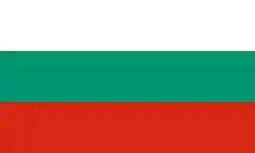 Bulgaria
Bulgaria Czechoslovakia
Czechoslovakia East Germany
East Germany Hungary
Hungary.svg.png.webp) Iraq: Destroyed during the 2003 invasion
Iraq: Destroyed during the 2003 invasion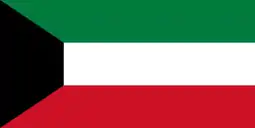 Kuwait: Captured by the Iraqi Army during the Gulf War
Kuwait: Captured by the Iraqi Army during the Gulf War Poland: 49 launchers in 1966-2001[15]
Poland: 49 launchers in 1966-2001[15] Romania
Romania South Yemen
South Yemen Soviet Union
Soviet Union.svg.png.webp) Yugoslavia
Yugoslavia
See also
References
- Terrill, W. Andrew (2009). Escalation and Intrawar Deterrence During Limited Wars in the Middle East. Strategic Studies Institute. pp. 38. ISBN 978-1-58487-406-5.
- "Archived copy". Archived from the original on 18 March 2017. Retrieved 18 March 2017.CS1 maint: archived copy as title (link)
- Iran-Iraq: Ballistic Missile Warfare and its Regional Implications CIA Directorate of Intelligence - 2 July 2012
- Cordesman, Anthony: Iraq and the War of Sanctions. Greenwood Publishing Group, 1999. Page 453. ISBN 0275965287
- Affairs, United States Department of State Bureau of African (1991). AF Press Clips. p. 7.
- "Engineers quietly do job, face deadly missile strike". Toledo Blade. Archived from the original on 2 June 2014. Retrieved 29 December 2015.
- "He (Lt. Col. Wesley, second in command) had gotten only thirty feet from his vehicle when a powerful Abril (sic) missile hit it dead center." Lacey, Jim:Takedown: the 3rd Infantry Division's twenty-one day assault on Baghdad. Naval Institute Press, 2007, page 243. ISBN 1-59114-458-2
- Zucchino, David (2004). Thunder Run: The Armored Strike to Capture Baghdad. Grove Press. p. 162.
- "Serbs Fired Surface-to-Surface Missile at Zupanja". FBIS Daily Report: East Europe. The Service (241–252). 12 December 1992.
- Županjac (2 December 2019). "Na današnji dan 2.12". Županjac.net (in Croatian). Retrieved 4 January 2020.
- Wood, John (2003). The Chance of War: Canadian Soldiers in the Balkans, 1992–1995. Dundurn. pp. 107. ISBN 1-55002-426-4.
- UK MOD Operation Ellamy Archived 11 July 2011 at the Wayback Machine from Global Security website, 9 May 2011
- "Archived copy". Archived from the original on 19 August 2017. Retrieved 19 August 2017.CS1 maint: archived copy as title (link)
- Military balance 2010
- Robert Rochowicz (2018) (in Polish). Rakiety operacyjne i taktyczne w Siłach Zbrojnych PRL. „Poligon” No. 1/2018(62), p. 61-68, ISSN 1895-3344
External links
| Wikimedia Commons has media related to 9K52 Luna-M. |
- FAS – Military Analysis Network
- Profile of the Frog 7 from The Whirlwind War a publication of the United States Army Center of Military History